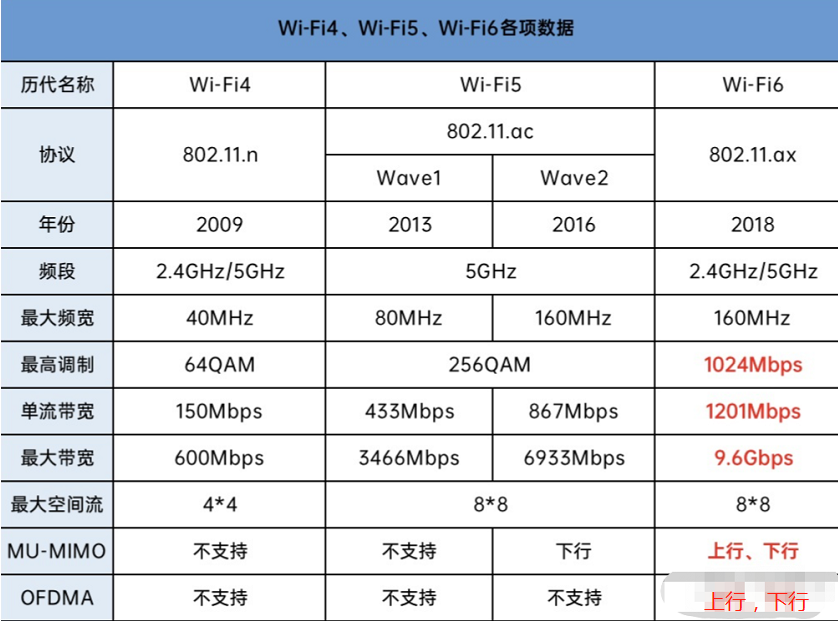IOT|WIFI5 vs WIFI6|IPQ4019/IPQ9554/QCN6274 wireless solution
Wi-Fi 5 and Wi-Fi 6 are the names of wireless networking standards, also known as 802.11ac and 802.11ax. They represent different wireless technology advancements and improvements. The following is their introduction and comparison:
Wi-Fi 5 (802.11ac):
Wi-Fi 5 is a wireless network standard released in 2013 and is the successor version of Wi-Fi 4 (802.11n).
It uses a higher frequency bandwidth and more advanced modulation techniques to provide faster data transfer rates and better performance.
Wi-Fi 5 has a theoretical top speed of 3.5 Gbps (gigabits per second), but actual speeds are often affected by signal strength and device limitations.
It supports more simultaneously connected devices and has better signal coverage and reliability.
Wi-Fi 6 (802.11ax):
Wi-Fi 6 is the latest wireless network standard released in 2019 and is the successor of Wi-Fi 5.
It introduces some important improvements designed to provide higher speeds, lower latency, and better performance, especially with high-density device connections.
Wi-Fi 6 supports higher frequency bandwidth and more advanced modulation techniques, which can achieve higher data transmission rates. It also uses OFDMA (Orthogonal Frequency Division Multiple Access) technology, which can handle the communication of multiple devices at the same time, improving network efficiency.
The highest theoretical rate of Wi-Fi 6 is 9.6 Gbps (gigabits per second), but the actual speed will also be limited by equipment and network conditions.
It also provides better signal coverage and lower power consumption, which can extend the battery life of the device.
Wi-Fi 5 and Wi-Fi 6 are wireless networking standards also known as IEEE 802.11ac and IEEE 802.11ax. They have the following differences:
Speed and throughput: Wi-Fi 5 has a maximum theoretical speed of 3.5 Gbps, while Wi-Fi 6 has a maximum theoretical speed of 9.6 Gbps. Wi-Fi 6 provides higher throughput and faster data transmission speed through higher modulation and coding technology and wider spectrum utilization.
Latency: Wi-Fi 6 uses a new technology called Target Wake Time (TWT), which reduces the standby power consumption of devices and reduces network latency. This is beneficial for applications that require real-time interaction, such as online games and video chats.
Device density: Wi-Fi 6 uses OFDMA (Orthogonal Frequency Division Multiple Access) technology to divide the wireless spectrum into multiple sub-channels, thereby being able to handle more device connections at the same time. This enables Wi-Fi 6 networks to perform better in environments with high device density, such as crowded public places or offices.
Security: Wi-Fi 6 introduces a stronger encryption standard (WPA3) to provide higher security protection. WPA3 replaces the outdated WPA2 and provides better cryptographic algorithms and protection mechanisms to prevent potential network attacks.
Compatibility: Wi-Fi 6 devices are backwards compatible with Wi-Fi 5 devices, which means they will work properly on Wi-Fi 5 networks. However, to take advantage of the full benefits of Wi-Fi 6, both Wi-Fi 6 routers and devices are required.
In general, Wi-Fi 6 has higher speeds, lower latency, better device density support, and stronger security than Wi-Fi 5. It is the next-generation wireless network standard, gradually replacing Wi-Fi 5 and becoming the mainstream. However, to enjoy the benefits of Wi-Fi 6, compatible routers and devices are required.
The differences and functions of wifi5 and wifi6 have been introduced above, and the needs of different scenarios are also different.
Wallys has developed and produced many industrial routers, network cards, etc., to meet the different project needs of different customers.
WiFi5 router motherboard: based on Qualcomm chip IPQ4019/IPQ4029.
Wifi5 network card, based on Qualcomm chip QCA9880/
Wifi6 router motherboard, based on Qualcomm chips IPQ6010/IPQ5018/IPQ9554/IPQ9072, etc.
The network card of wifi5 is based on Qualcomm chip QCN6274/QCN9024/MTK chip MT7915, etc.
Wallys has over 10 years of research and development experience, experienced in linux, wifi protocol and other aspects, Qualcomm chip development drivers, kernel and other important software development, modification and compilation, to meet customers' different wifi functional needs.
We have a strong hardware design team, and experienced people know that the most difficult part of hardware design is RF circuit design, baseband, etc., while wallys team made 0 error to achieve signal integrity, such as frequency conversion of network card, from 2.4G to 900M, which is a technological breakthrough.
Clients: TIP,Facebook, Openwrt, etc
Email:sales@wallystech.com
WEB:https://www.wallystech.com/




































